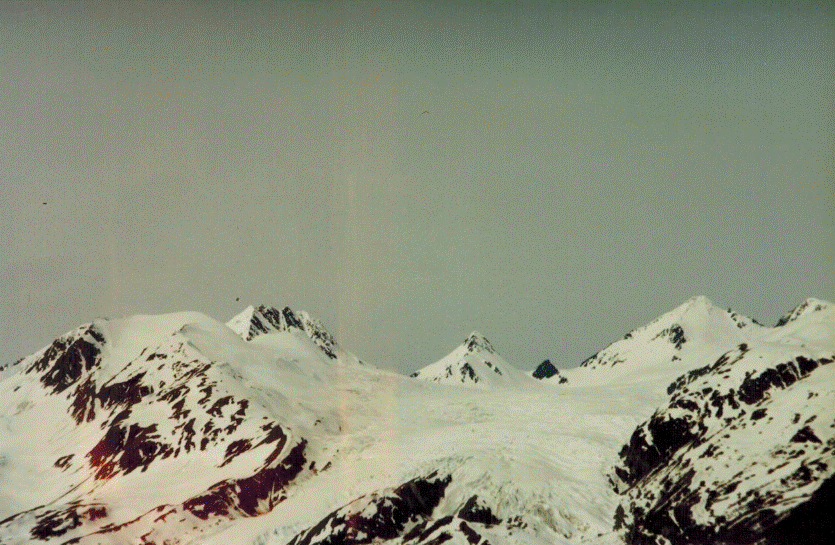BY JANET STEINBERG
It has been reported
that millions of Americans are “lining up (and falling down) to take the
extreme sports plunge”. There are sport climbers who scale sheer cliffs
using only ropes; bicycle stunt riders that break the laws of physics;
skateboarders who ride off an obstacle and free-fall to the ground; and
downhill skaters that blade at 50 mph.
that millions of Americans are “lining up (and falling down) to take the
extreme sports plunge”. There are sport climbers who scale sheer cliffs
using only ropes; bicycle stunt riders that break the laws of physics;
skateboarders who ride off an obstacle and free-fall to the ground; and
downhill skaters that blade at 50 mph.
Then there are those
fearless extreme skiers who feel that skiing on lifts is just practice for the
real thing. Once they’ve skied the Alps, and once they’ve skied the
Rockies, the extreme skiers in Alaska pose the question : “Are you ready
for the Chugach?”
fearless extreme skiers who feel that skiing on lifts is just practice for the
real thing. Once they’ve skied the Alps, and once they’ve skied the
Rockies, the extreme skiers in Alaska pose the question : “Are you ready
for the Chugach?”
Alaska’s rugged
7000-foot Chugach Mountain Range is famous for it steep descents and its
500-plus inches of annual snowfall. It is a challenging mountain
adventure for competent, experienced alpine skiers and snowboarders who seek
challenge and adventure and have health respect for real alpine environments
and their hazards.
7000-foot Chugach Mountain Range is famous for it steep descents and its
500-plus inches of annual snowfall. It is a challenging mountain
adventure for competent, experienced alpine skiers and snowboarders who seek
challenge and adventure and have health respect for real alpine environments
and their hazards.
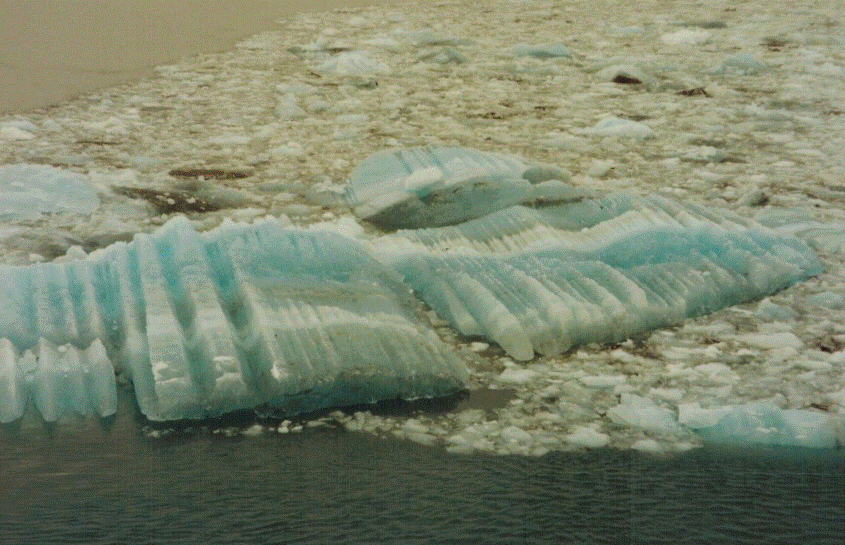 |
| MOTHER NATURE’S SCULPTURE IN VALDEZ |
An extreme heli-ski
day in the Chugach begins in the morning with helicopters filled with skiers
who are dropped on the mountain. Daylight lasts until 7 p.m. in
March, 9 p.m. in April, and 11 p.m. in May. Runs are long and
adventurous with time taken to enjoy the scenery and learn about mountain
safety. Ski runs range from 2500 to 5000 vertical
feet. But who’s counting?
day in the Chugach begins in the morning with helicopters filled with skiers
who are dropped on the mountain. Daylight lasts until 7 p.m. in
March, 9 p.m. in April, and 11 p.m. in May. Runs are long and
adventurous with time taken to enjoy the scenery and learn about mountain
safety. Ski runs range from 2500 to 5000 vertical
feet. But who’s counting?
Being the non-skier
that I am, my visit to Valdez, and the Tsaina Lodge atop Thompson Pass, took
place in the summer. The contemporary 24-room Tsaina Lodge offers cozy
accommodations, gourmet dining, and pristine surroundings boasting heli-access
to the most remote fishing spots from its on-property heli-pad.
that I am, my visit to Valdez, and the Tsaina Lodge atop Thompson Pass, took
place in the summer. The contemporary 24-room Tsaina Lodge offers cozy
accommodations, gourmet dining, and pristine surroundings boasting heli-access
to the most remote fishing spots from its on-property heli-pad.
The Tsaina Bar has a
colorful history as the center of extreme and freeride innovation in the early
1990s. It continued to serve many an adventurous heli-skier and snowboarder
until its closure several years ago. The Tsaina Bar has now returned.
Much of the original furnishings, including the bar, pool table, and wood stove have been restored and relocated in the
modern lodge.
colorful history as the center of extreme and freeride innovation in the early
1990s. It continued to serve many an adventurous heli-skier and snowboarder
until its closure several years ago. The Tsaina Bar has now returned.
Much of the original furnishings, including the bar, pool table, and wood stove have been restored and relocated in the
modern lodge.
Anadyr Adventures allows tourists to
experience remote, spectacular glacial fjords, tidewater glaciers, and marine
bird and mammals in their natural habitat. Anadyr
Adventures offers four types of trips: day trips for those with limited time in
Valdez, multi-day camping
trips, Mothership
trips for those desiring the amenities of a support vessel, and lodge based trips offering Prince William
Sound day excursions from the comfort of a remote Alaskan wilderness lodge.
experience remote, spectacular glacial fjords, tidewater glaciers, and marine
bird and mammals in their natural habitat. Anadyr
Adventures offers four types of trips: day trips for those with limited time in
Valdez, multi-day camping
trips, Mothership
trips for those desiring the amenities of a support vessel, and lodge based trips offering Prince William
Sound day excursions from the comfort of a remote Alaskan wilderness lodge.
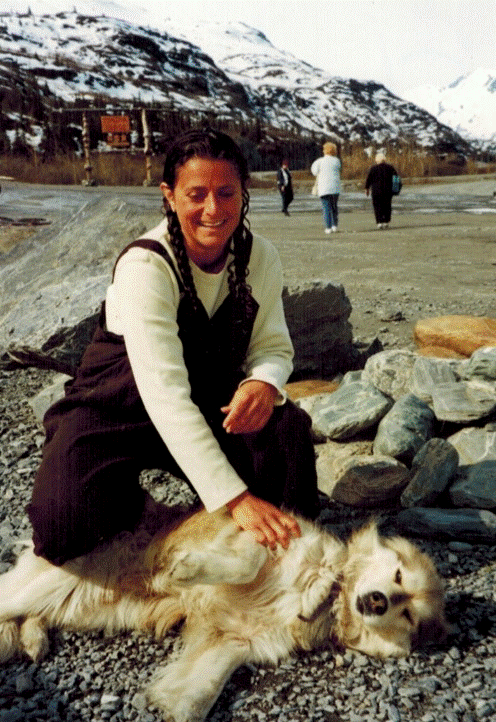 |
|
RELAXING
VALDEZ STYLE |
If you’re not a
skier, your visit to Valdez will more than likely be in the summer, as part of
a cruise or land-tour vacation. (During the winter, more than 300 inches of
snow is measured annually in the city and the nearby Thompson Pass has recorded
more than 900 inches in one year.)
skier, your visit to Valdez will more than likely be in the summer, as part of
a cruise or land-tour vacation. (During the winter, more than 300 inches of
snow is measured annually in the city and the nearby Thompson Pass has recorded
more than 900 inches in one year.)
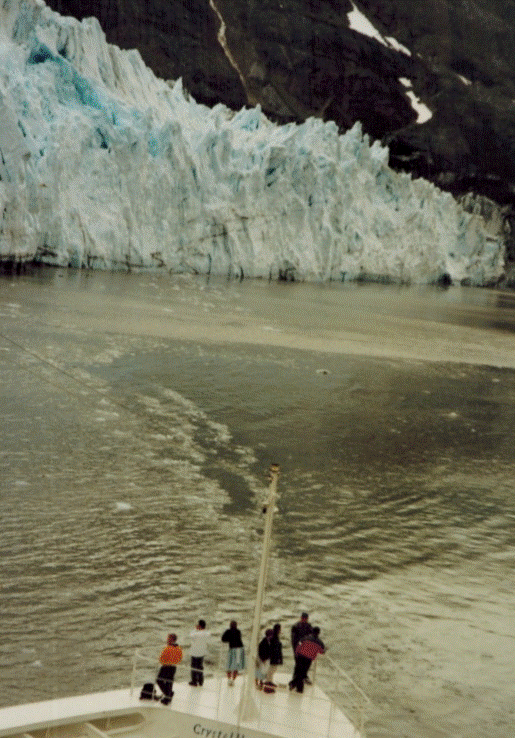 |
| APPROACHING VALDEZ ON A CRUISE SHIP |
Before you go, it is
interesting to know a bit about the town’s history. The city of Valdez
(pronounced Val-deez) lies at the head of Valdez Arm in a natural fjord
that reaches inland 12 miles from Prince William Sound. Captain Cook
sailed through the area in 1778.
interesting to know a bit about the town’s history. The city of Valdez
(pronounced Val-deez) lies at the head of Valdez Arm in a natural fjord
that reaches inland 12 miles from Prince William Sound. Captain Cook
sailed through the area in 1778.
In 1897-98, Klondike
gold seekers came to Valdez and found no town and no trail. A tent city
sprang up at the head of the bay and Valdez was formed. There were 4000
stampeders traveling through Valdez that year. Some enterprising men
stayed to set up shops and other businesses.
gold seekers came to Valdez and found no town and no trail. A tent city
sprang up at the head of the bay and Valdez was formed. There were 4000
stampeders traveling through Valdez that year. Some enterprising men
stayed to set up shops and other businesses.
In June of 1906,
Daniel Guggenheim (of the family of industrialists and philanthropists) joined
the Morgan bank to form the Alaska Syndicate. Their goal was to develop a
copper mine and an access railroad. Subsequent mergers led to the
formation of the Kennecott Corporation and, ultimately, the development of
mines. By 1920, the population of Valdez began to slowly decline to
400-500 people. In 1923, the army closed its Valdez facility.
Daniel Guggenheim (of the family of industrialists and philanthropists) joined
the Morgan bank to form the Alaska Syndicate. Their goal was to develop a
copper mine and an access railroad. Subsequent mergers led to the
formation of the Kennecott Corporation and, ultimately, the development of
mines. By 1920, the population of Valdez began to slowly decline to
400-500 people. In 1923, the army closed its Valdez facility.
On Good Friday, 1964,
disaster struck Valdez. A four-minute earthquake, measured at 8.6 and
officially upgraded to 9.2, triggered large tsunami waves that washed away the
dock drowning 32 people. The whole townsite, which sat on unstable
ground, was condemned. Over the next four years the town was relocated to
its present site.
disaster struck Valdez. A four-minute earthquake, measured at 8.6 and
officially upgraded to 9.2, triggered large tsunami waves that washed away the
dock drowning 32 people. The whole townsite, which sat on unstable
ground, was condemned. Over the next four years the town was relocated to
its present site.
In the late 1960’s
Valdez was chosen to be the terminus of the 800-mile Trans-Alaska
Pipeline. The population zoomed to 10,000. After the oil started
flowing in the summer of 1977, the population began to decline. By
January of 1989, the town population had settled to 3500. In 2010, the
population was 3976.
Valdez was chosen to be the terminus of the 800-mile Trans-Alaska
Pipeline. The population zoomed to 10,000. After the oil started
flowing in the summer of 1977, the population began to decline. By
January of 1989, the town population had settled to 3500. In 2010, the
population was 3976.
The Alyeska Marine
Terminal, where crude oil is loaded into giant tankers for shipment to
refineries in the Lower 48, is just across the bay from Valdez.
Terminal, where crude oil is loaded into giant tankers for shipment to
refineries in the Lower 48, is just across the bay from Valdez.
On Good Friday, 1989,
disaster struck Valdez again. The oil tanker Exxon Valdez struck Bligh
Reef, causing the largest oil spill in North American history and thrusting
Valdez into the international media limelight.
disaster struck Valdez again. The oil tanker Exxon Valdez struck Bligh
Reef, causing the largest oil spill in North American history and thrusting
Valdez into the international media limelight.
Today, in addition to
the oil industry, tourism plays a vital role in the area’s economy. Attractions
and points of interest in “Alaska’s Little Switzerland” include the
following:
the oil industry, tourism plays a vital role in the area’s economy. Attractions
and points of interest in “Alaska’s Little Switzerland” include the
following:
VALDEZ MUSEUM, claiming to be the
best small museum in the state, contains relics from Old Town Valdez,
aviation heritage and the history of the Exxon Valdez oil spill.
best small museum in the state, contains relics from Old Town Valdez,
aviation heritage and the history of the Exxon Valdez oil spill.
PETER TOTH INDIAN
CARVINGS,
on permanent display at the Prince William Sound Community College
were carved by Hungarian-born Peter Toth who, in 1971, had undertaken a
vow to carve an Indian sculpture in each of the 50 states. Since
beginning his mission in 1971, Peter has completed 67 Whispering Giants in all
50 states and Canada, as well as a sculpture in Hungary, completed in 2008.
CARVINGS,
on permanent display at the Prince William Sound Community College
were carved by Hungarian-born Peter Toth who, in 1971, had undertaken a
vow to carve an Indian sculpture in each of the 50 states. Since
beginning his mission in 1971, Peter has completed 67 Whispering Giants in all
50 states and Canada, as well as a sculpture in Hungary, completed in 2008.
RUTH POND is a wonderful
mini-park surrounded by towering mountains. It is a
perfect picnic spot, surrounded by a large grassy area, and available for
swimming and boating.
mini-park surrounded by towering mountains. It is a
perfect picnic spot, surrounded by a large grassy area, and available for
swimming and boating.
WORTHINGTON GLACIER is preserved as a
State Recreation Site. Visitors can drive almost to the face of this
massive glacier and hike the one-mile trail alongside the moraine. Caution:
Do not walk onto the glacier or the moraine (accumulation of earth and stones
left by the glacier). Slight events can cause sudden collapse or
crevasses to appear with no warning.
State Recreation Site. Visitors can drive almost to the face of this
massive glacier and hike the one-mile trail alongside the moraine. Caution:
Do not walk onto the glacier or the moraine (accumulation of earth and stones
left by the glacier). Slight events can cause sudden collapse or
crevasses to appear with no warning.
ALYESKA PIPELINE
TERMINAL,
the southern terminus of the 800-mile pipeline, is no longer offering tours due
to increased security since 9/11/01.
TERMINAL,
the southern terminus of the 800-mile pipeline, is no longer offering tours due
to increased security since 9/11/01.
KEYSTONE CANYON is laced with
glaciers and waterfalls such as the stunning Horsetail Falls and the
cascading 800-foot Bridal Veil Falls.
glaciers and waterfalls such as the stunning Horsetail Falls and the
cascading 800-foot Bridal Veil Falls.
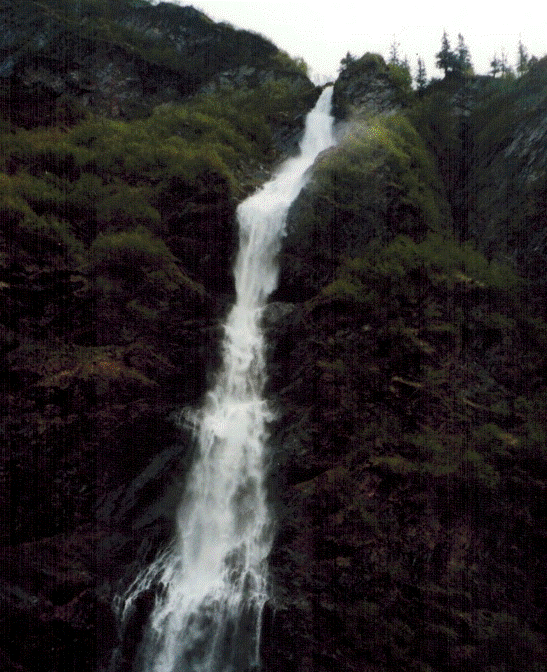 |
|
WATERFALLS
ABOUND IN VALDEZ |
RAFTING AND KAYAKING on the Lowe River
provides an exhilarating outing and a chance to see the beautiful Keystone
Canyon up close.
provides an exhilarating outing and a chance to see the beautiful Keystone
Canyon up close.
SHOPPING for authentic
Klondike gold nuggets in the few small gift shops can be advantageous if you do
your homework beforehand. Be advised that there are 20 pennyweights of
gold in one troy ounce.
Klondike gold nuggets in the few small gift shops can be advantageous if you do
your homework beforehand. Be advised that there are 20 pennyweights of
gold in one troy ounce.
Whether your
interested in shiny yellow gold, oily black goo, or magnificent blue ice,
Valdez is a colorful spot to visit during the season of your choice.
interested in shiny yellow gold, oily black goo, or magnificent blue ice,
Valdez is a colorful spot to visit during the season of your choice.
JANET STEINBERG is an
award-winning Travel Writer and a Travel Consultant affiliated with
The Travel Authority, Mariemont/Cincinnati, Ohio office.
award-winning Travel Writer and a Travel Consultant affiliated with
The Travel Authority, Mariemont/Cincinnati, Ohio office.

